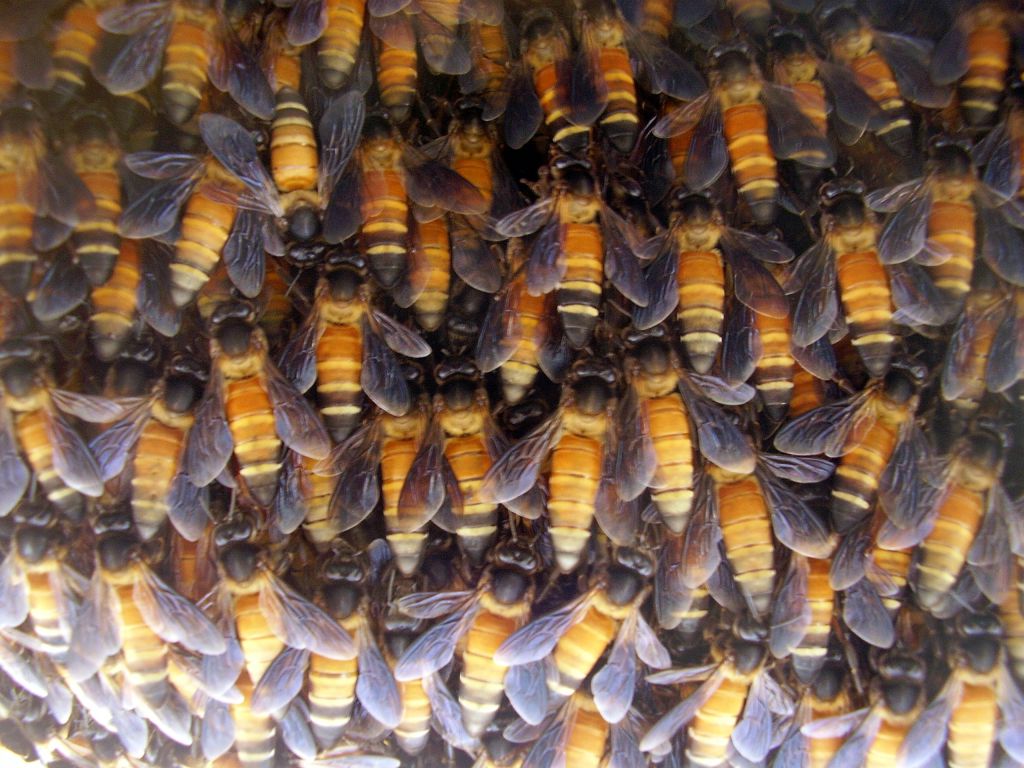- Apis dorsata
Taxobox
name = Giant honey bee

image_width = 220px
image_caption = Close-up of workers on comb
regnum =Animal ia
phylum =Arthropod a
classis =Insect a
subclassis =Pterygota
infraclassis =Neoptera
superordo =Endopterygota
ordo =Hymenoptera
subordo =Apocrita
familia =Apidae
genus = "Apis"
subgenus = "(Megapis)"
species = "A. dorsata"
binomial = "Apis dorsata"
binomial_authority = Fabricius,1793 "Apis dorsata", the Giant honey bee, is a
honey bee of southern and southeasternAsia mainly in forested areas like theTerai ofNepal . The subspecies with the largest individuals is the Himalayan cliff honey bee - "Apis dorsata laboriosa " - but typical "Apis dorsata" workers from other subspecies are around 17-20 mm long (nearly one inch).Nests are mainly built in exposed places far off the ground, on tree limbs and under cliff overhangs, and sometimes on buildings. "Apis dorsata" is an aggressive bee and has never been domesticated (as they do not use enclosed cavities for nesting). They can be extremely dangerous if the colony is provoked. Each colony consists of a single vertical comb (sometimes approaching a square metre) suspended from above, and the comb is typically covered by a dense mass of bees in several layers. When disturbed, the workers may exhibit a defensive behavior known as defense waving. Bees in the outer layer thrust their abdomens ninety degrees in an upward direction and shake them in a synchronous way. This may be accompanied by stroking of the wings. The signal is transmitted to nearby workers that also adopt the posture, thus creating a visible (and audible) "ripple" effect across the face of the comb, in an almost identical manner to an audience wave at a crowded stadium.These bees are tropical and in most places they migrate seasonally. Some recent evidence indicates that the bees return to the same nest site, even though most, if not all, the original workers might be replaced in the process. The mechanism of memory retention remains a mystery.
Despite its aggressive nature, indigenous peoples have traditionally used this species as a source of honey and beeswax, a practice known as "
honey hunting ".Subspecies
Engel (1999) recognized the following
subspecies :
*"Apis dorsata dorsata"; primarily fromIndia
*"Apis dorsata binghami " Cockerell; (Indonesian honey bee ) fromMalaysia andIndonesia
*"Apis dorsata breviligula " Maa; from thePhilippines
*"Apis dorsata laboriosa "Fabricius ; (Himalaya n cliff honey bee), also inMyanmar ,Laos , and southernChina .The latter is not distinct morphologically from the nominate, but has different housekeeping and swarming behavior, allowing it to survive at high altitudes. In addition, there has been little
gene flow between it and "A. dorsata" for millions of years; accordingly, some (Arias & Sheppard 2005) argue that it should be classified as a species. Likewise, the southeasterntaxon "binghami" seems also to be distinct. The limits of their ranges inIndochina and the possible distinctness of the geographically distant Philippines population require more study (Arias & Sheppard 2005). However, the use of the taxonomic rank of "subspecies" is typical for geographically discrete populations, so the difference in opinion here is whether or not to recognize the rank of subspecies or not (i.e., no one is disputing that they are distinct lineages, the dispute is over whether to call them "species").References
* (2005): Phylogenetic relationships of honey bees (Hymenoptera:Apinae:Apini) inferred from nuclear and mitochondrial DNA sequence data. "Molecular Phylogenetics and Evolution" 37(1): 25–35. doi|10.1016/j.ympev.2005.02.017. Erratum in "Molecular Phylogenetics and Evolution" 40(1): 315. doi|10.1016/j.ympev.2006.02.002
* (1999): The taxonomy of recent and fossil honey bees (Hymenoptera: Apidae: "Apis"). "Journal of Hymenoptera Research" 8: 165-196.
Wikimedia Foundation. 2010.
